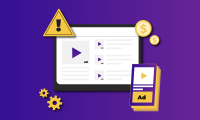The Ultimate List of Ad Spend Statistics for Digital Publishers in 2023
Statistics are the crystal ball of the ad tech industry, revealing potential outcomes and future predictions based on patterns and data. 2023 can be the year of rising economic challenges and shrinking ad budgets. How to stay ahead of the curve in such times? Focus on statistics and use the insights to feed the appetite of consumers with high-quality content and the demands of advertisers by identifying ad tech trends.
From immersive digital ad formats to the depletion of third-party cookies, 2023 is subject to many paradigm shifts. Publishers can position themselves for success by capitalizing on emerging opportunities. Here is the ultimate list of ad spend statistics for digital publishers to make strategic choices that align with the latest developments in the industry.
- Global digital ad spend
As far as digital ad spends are concerned the prospect of budget cuts is a worry for digital publishers. But not all markets or niches are expected to make cutbacks. While it was once predicted that digital ad spends would grow exponentially, the reality is that the rate of growth is likely to be slower than previously thought. But publishers can take heart in knowing that even with the deceleration, the 2023 global ad spends is projected to be USD 626.26 million. It is expected to grow by 11.0% in 2024 and reach USD 695.96 million.
- CTV Ad Spend
Audiences are migrating back to their couches soaking in the ‘Big Screen’ experience leading to a rise in CTV and OTT content viewership. The increasing popularity of CTV can also be attributed to the shift towards streaming services, the increase in vernacular content and the availability of more affordable internet-enabled devices. In terms of audience quality, CTV surpasses both display ads and online video ads with a 12% and 10% higher audience quality, respectively. By 2026, CTV ad spends are expected to reach USD 28 million.
- Mobile Ad Spend
Advertisers are increasingly investing in mobile advertising to reach their target audience and monetize the growing usage of mobile devices. In addition, advancements in mobile technology, the availability of more sophisticated targeting and tracking tools, an increase in app downloads, and the booming gaming industry have made mobile advertising more effective and efficient. In 2022, the global mobile ad spend was $336 billion. The new report by Data.ia says that the growth of short-form video and video-sharing apps, such as TikTok and YouTube, is expected to propel mobile ad spend to reach $362 billion by 2023.
- Programmatic Ad Spend
Programmatic advertising offers several benefits for advertisers, including improved efficiency, better targeting, and increased transparency. In 2022, ads bought programmatically were expected to account for 84% of global digital advertising spending. The share is forecast to increase to 87% by 2026 and reach USD 725 billion. With advances in technology and data analytics, the growth of programmatic ad trends will escalate progressively in the coming years.
- Digital Video Ad Spend
The projected spending on video advertising is expected to reach USD 210.20 billion by 2023, with an estimated annual growth rate (CAGR 2023-2027) of 10.97%. This growth is projected to result in a market volume of USD 318.80 billion by 2027. Video content is more engaging than other forms of content, such as text or images. Digital video ads can capture users’ attention and create an emotional connection with the brand, leading to higher engagement rates which have created more opportunities for advertisers to reach their target audience.
- Audio Ad Spend
The popularity of podcasts has surged in recent years, with millions of people tuning in regularly. This has prompted many publishers to turn to audio content and create their own podcasts, thereby generating more opportunities for audio advertising. The global digital audio advertising market is expected to grow at a CAGR of 7.28% from 2023 to 2027, with a projected spending of USD 8.95 billion by 2023, and an estimated market volume of USD 11.85 billion by 2027.
- Native Ad Spend
Native advertising is known for being seamless and unobtrusive. However, it depends on the type of native ads that marketers use. The positive reception of this ad format has led to a steep increase in native ad spends. Adflex’s latest data shows that the native advertising spend is expected to skyrocket to USD 98 billion in 2023, with year-over-year increases contributing to this surge.
- Search Ad Spends
Search advertising can help publishers to build relationships with advertisers, which can lead to additional revenue opportunities. By working closely with advertisers, publishers can create targeted ad campaigns that deliver high ROI for both parties. According to market projections, the search advertising segment is anticipated to reach a staggering USD 296.70 billion in ad spending by 2023. Further, this sector is expected to register an annual growth rate (CAGR 2023-2027) of 10.05%, leading to a predicted market volume of USD 435.20 billion by 2027.
- OOH Ad Spends
OOH advertising is a highly effective marketing tool that helps to reinforce brand messaging through repeated exposure to consumers. With its ability to create memorable and visually striking messages, OOH ads leave a remarkable impact on viewers. According to recent data, the global out-of-home (OOH) advertising market expanded from USD 28.48 billion in 2022 to USD 31.23 billion in 2023, representing a compound annual growth rate (CAGR) of 9.7%. Looking ahead, market analysts predict that the OOH advertising sector will continue to grow, reaching an estimated value of USD 43.96 billion by 2027, with an expected CAGR of 8.9%.
- Contextual Ad Spends
In today’s hyper-competitive advertising landscape, personalization helps reduce ad waste and optimize budgets for maximum impact. Hence, contextual advertising is gaining momentum. With the upcoming end of third-party cookies, this ad tech trend is poised for success. The contextual advertising market was valued at USD 157.4 billion in 2020 and is expected to expand significantly and reach USD 376.2 billion by 2027, with a remarkable compound annual growth rate (CAGR) of 13.3% during the forecast period of 2020-2027.
The insights gleaned from the above statistics can be invaluable to publishers seeking to remain competitive in an ever-evolving digital advertising landscape. They indicate a promising outlook with substantial potential for expansion. By analyzing this data, publishers can determine the most effective ad formats, trends, and markets to target, which can help them remain resilient in the face of potential economic downturns and tackle the fast-moving dynamics of the ad tech landscape.




Leave a Reply